Table of contents
- Ducati shifts seamlessly Next Panigale with MotoGP gearbox?
- Seamless vs. double clutch
- Panigale with MotoGP transmission?
- Conclusion
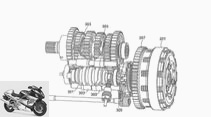
Ducati.
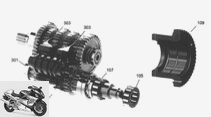



6th pictures
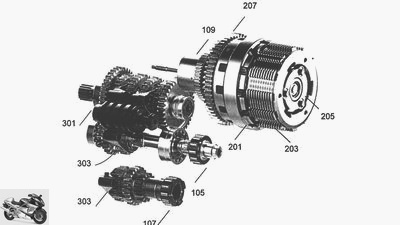
Ducati
1/6
The seamless gears from MotoGP are known. For a good 10 years now, the drivers have been shifting load changes here.
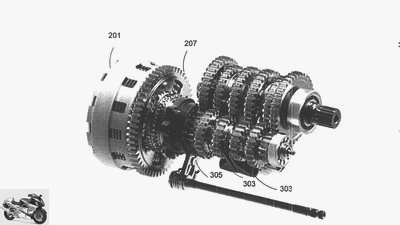
Ducati
2/6
The Prinzop is similar to the DCT from Honda, but only needs one clutch.

Ducati
3/6
The frictional connection on the two-part input shaft is controlled by a type of hub gear # 109 via two roller bearings # 105 and # 107.
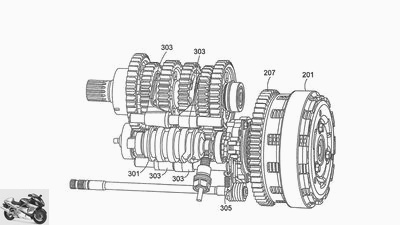
Ducati
4/6
The shift drum is designed to have two gears engaged at the same time and to take one gear out of gear while the other gear begins to transmit power.
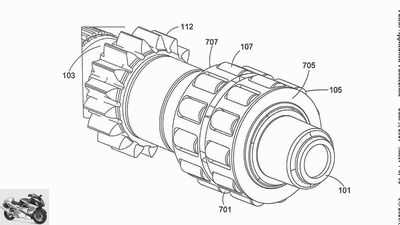
Ducati
5/6
The two roller bearings sit under a hub in the clutch basket.
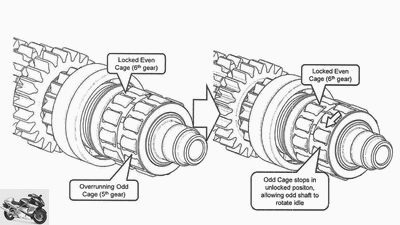
Ducati
6/6
Depending on the position of the hub, a bearing runs freely.
counselor
technology & future
Ducati patent: Seamless transmission from MotoGP
Ducati shifts seamlessly
Next Panigale with MotoGP gearbox?
Seamless gears have been standard in MotoGP for a good 10 years. They work like a dual clutch transmission, with only one clutch. Ducati seems to be adapting the system for the street.
Jens Kratschmar
07/07/2021
In this article:
- Seamless vs. double clutch
- Panigale with MotoGP transmission?
- Conclusion
When Honda brought the seamless transmission to the 800cc class in 2010, the last MotoGP year, it had to be guarded by its own security guard. That was how revolutionary the system was. The drivers were able to shift up gears under full load and without interrupting the tractive effort and thus prevent the so-called shift shock. This occurs with quick gear changes under high load, causes unrest in the chassis due to torque peaks and also torments the tires. On the road, you can feel the shift shock with the Quickshifter when the rear shakes slightly when changing gears or the motorcycle briefly moves around its vertical axis. Seamless puts an end to the shift shock. It goes without saying that all manufacturers followed suit. Ducati were the first. And they are probably the first to want to bring the function to the road.
Seamless vs. double clutch
Basically, the seamless gear works like the DCT from Honda, just with just one clutch. A conventional shift drum always engages two gears at the same time on a two-part input shaft. One gear pairing runs freely while the other transmits the torque. If the driver initiates a gearshift conventionally with his foot, he not only turns the gearshift drum, but also frees the next gear while the previous gear is taken out. With this rotation, the next gear is already brought forward. The DCT transmission from Honda works in a similar way, only here the traction is controlled by a second clutch. In the case of seamless gears, this task is performed by a kind of freewheel by means of a strong roller bearing that may or may not be subjected to force via a hub.
Now comes the second important part: it is not enough just to take the power off the shaft, the gear wheels of the pairing presented must also run free. Otherwise the gearbox would brake and possibly even destroy itself. This is done by means of locking blades in the bearing of the gears. If there is no load on the part of the shaft, the wheels turn freely. If the power to the next gear is closed by the switching process, small recesses in the shaft close the pawls exactly at the moment when the frictional connection switches. A small, fine mechanical masterpiece. And it is precisely here, as with the two hub-controlled roller bearings, that the greatest potential lies: The parts have to last thousands of kilometers without revision or failure. In racing, the transmissions are regularly revised.
Panigale with MotoGP transmission?
In the end, the construction shown is likely to differ somewhat from that used in MotoGP, as the mechanical solutions clearly indicate use in an existing transmission housing of a conventional engine. Ducati would like to have this clarified in the patent specification. It can therefore be used as a series transmission in a new Panigale V4 conceivable and later also in other powerful engines. The biggest advantage is: The transmission does not need any electronic or hydraulic components. Only the engine control needs information about the type of gearbox, because when downshifting the shafts need a throttle to get the shaft free of load, shifting continues with the quickshifter, only faster and quieter.
Conclusion
Pictures, photos, very precise descriptions, a history in MotoGP spanning almost a decade and indeed a benefit to be recognized in a normal motorcycle: the seamless transmission from Ducati will come into series production, the only question is when.
Related articles
-
Technology: Seamless transmission from the Honda RC 213 V.
2snap Sports & scene Motorsport Technology: Seamless transmission from the Honda RC 213 V. MOTOGP technology seamless gear of the Honda RC 213 V Full…
-
Transmission technology in racing
2snap 22nd pictures Gargolov 1/22 With the motorcycles of the early years with their fuel shift levers, a gear change took what felt like an eternity….
-
Patent semi-automatic transmission for Suzuki Hayabusa
Suzuki 6th pictures Suzuki 1/6 Suzuki has patented a semi-automatic transmission. Suzuki 2/6 The patent relies on a conventional transmission with a…
-
Casey Stoner’s MotoGP Ducati for sale
Speer Limbacher motorcycle 6th pictures Speer Limbacher motorcycle 1/6 The MotoGP factory machines from 2008 had 799 cubic capacity distributed over four…
-
MotoGP 2021: Rossi thinks about the end of his career, Miller about Ducati
2snap. Sports & scene Motorsport MotoGP 2021: Rossi thinks about the end of his career, Miller about Ducati MotoGP starting field for 2021 Rossi thinks…
-
Gresini in MotoGP: move from Aprilia to Ducati
Gresini Racing Sports & scene Motorsport Gresini in MotoGP: move from Aprilia to Ducati Gresini in MotoGP Switch from Aprilia to Ducati The Italian…
-
Ducati MotoGP: Jack Miller extends until 2022
Ducati Sports & scene Motorsport Ducati MotoGP: Jack Miller extends until 2022 Ducati in MotoGP Jack Miller extends until 2022 Jack Miller extends his…
-
Rossi’s VR46 team: into MotoGP with Ducati
MotoGP Sports & scene Motorsport Rossi’s VR46 team: into MotoGP with Ducati Rossi’s VR46 team Three-year deal with Ducati for MotoGP It was speculated…
-
MotoGP Pramac Ducati: 2021 with Zarco and Martin
Pramac Racing 8th pictures Pramac Racing 1/8 The Ducati satellite team is completely repositioned for the 2021 season. Pramac Racing 2/8 After Jack…
-
Ducati’s strategy for the 2016 MotoGP season
Kirn 8th pictures 2snap 1/8 For two years the Ducati racing department has been working to catch up with the apparently superior Japanese motorcycle…